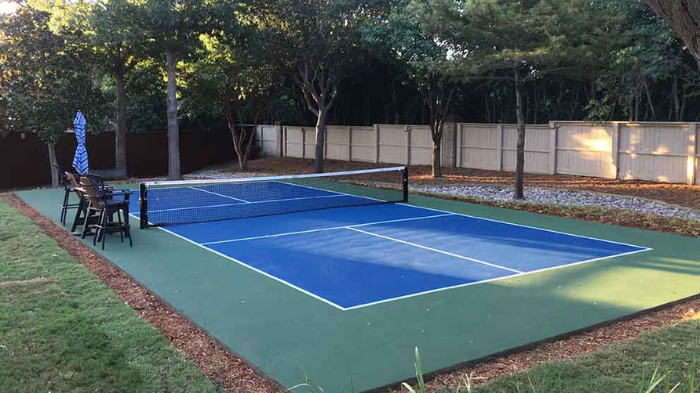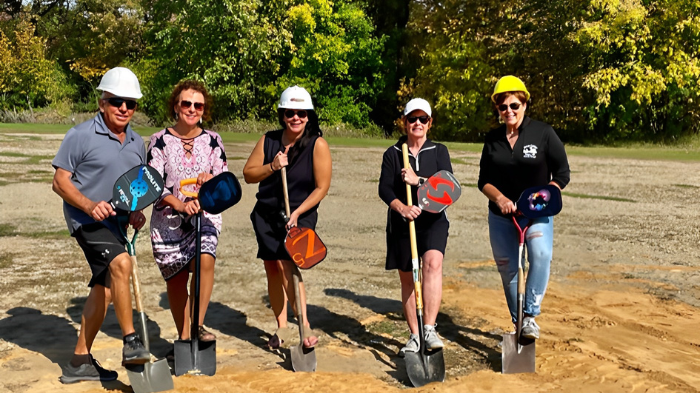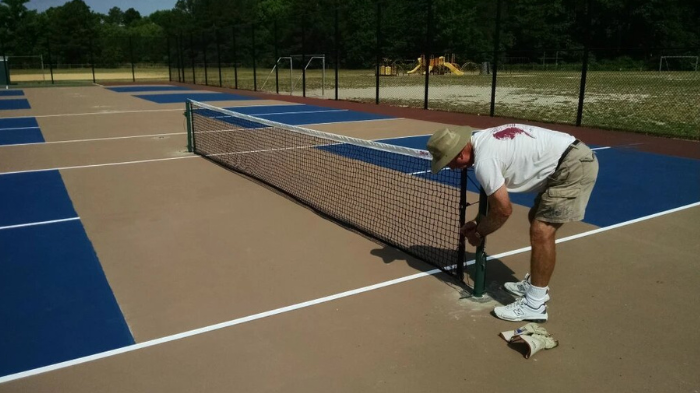Are you a pickleball enthusiast planning to build your own outdoor pickleball court? If yes, then you are at the right place. In this blog post, we are going to explain step-by-step on how to build an outdoor pickleball court.

From measuring the available space to adding those final finishing touches, we’ll guide you through each step of the process. Get ready to embark on this exciting project and build an excellent pickleball court that you can enjoy for years to come!
Steps for Building an Outdoor Pickleball Court
Building an outdoor pickleball court requires careful planning and execution. Here is a step-by-step guide on how to build an outdoor pickleball court:
Step 1: Determine The Available Space
Measure the space you have available for building the court. A standard pickleball court for doubles play is typically 20 feet wide and 44 feet long, but you may need extra room for boundaries and fencing if you want them. Make sure that the area is relatively flat and does not have any obstacles or uneven surfaces.
Step 2: Obtain Necessary Permits And Permissions
Contact your local municipality or relevant authorities to inquire about the permits or permissions required for building a pickleball court. The requirements may differ depending on your specific location. It is important to verify whether any approvals or authorizations are necessary before proceeding with the construction of the court.
Step 3: Gather Materials And Equipment
To build an outdoor pickleball court, you will need the following tools and materials:
- Tape Measure: This tool is used to precisely measure the dimensions of the court, ensuring accurate sizing during construction.
- Marking Paint Or Chalk: This paint or chalk is specially formulated for marking lines on the court. It is applied to create the boundary lines, such as the sidelines and baseline, clearly defining them on the playing surface. This ensures that players can easily see and follow the boundaries during the game.
- Stakes: Stakes are long and pointed objects that you insert into the ground at the corners of the court. They act as markers, assisting you in accurately determining the exact positions of the corners for your pickleball court.
- String Or Twine: String or twine is a thin and flexible material that is utilized to create straight lines and connect the stakes. It is essential for maintaining alignment and accurately establishing the boundaries of the pickleball court.
- Construction Flags Or Cones: While not mandatory, construction flags or cones can be valuable for providing visual guidance during the construction of the court. These markers assist in visually identifying and referencing specific points or areas of the court. They play a crucial role in enhancing accuracy and maintaining consistency throughout the construction process.
- Shovel Or Excavator: A shovel or excavator is used to dig and remove the grass or topsoil from the area where the court will be constructed. This tool helps to clear the ground, creating a clean and level surface for building the pickleball court.

- Gravel: Gravel is used to build a strong and stable foundation for the court. It is spread evenly over the excavated area to provide a solid base that supports the pickleball court structure. The gravel helps to ensure that the court surface remains level and durable during gameplay.
- Vibrating Plate Compactor Or Hand Tamper: These tools are employed to compress and flatten the layer of gravel effectively. By applying pressure and vibration with a plate compactor or manual tamping with a hand tamper, the gravel is compacted thoroughly. This process eliminates any loose spaces and creates a level surface that enhances the stability and durability of the pickleball court.
- Pickleball Net System: The pickleball net system consists of a net, posts, and mechanisms for adjusting the tension and setting up the net. It provides all the necessary components to install and secure the net properly for pickleball play.
- Outdoor Paint (Optional): Outdoor paint can be used to apply the court lines, enhancing visibility during gameplay. This optional step involves painting the lines on the court surface, making them easier to see and follow while playing pickleball.
These tools and materials will help you complete each step of the construction process effectively.
Step 4: Mark The Court Boundaries
To mark the corners of the court, begin at one corner and utilize a tape measure along with stakes. Measure a distance of 20 feet along one side, and then securely place a stake at that specific location. Repeat this process for all four corners of the court. By following these steps, you can ensure that the corners are accurately marked, guaranteeing the proper sizing and dimensions of the court.
Use string or twine to connect the stakes, ensuring that the lines are straight and create a square shape. This step helps to establish the proper alignment and dimensions of the court. To ensure accuracy, you can use a carpenter’s square or a right-angle tool to check that the corners form perfect right angles. This ensures that the court is properly squared off and maintains the correct shape during construction.
After marking the boundaries, use marking paint or chalk to draw the court lines, which include the baseline, sidelines, and centerline. This step is important as it clearly defines the playing area, making the court lines easily visible during gameplay. The marked lines help the players to understand the boundaries and ensure fair play on the court.
Step 5: Excavate The Court Area
Utilize a shovel or excavator to remove the grass or topsoil within the marked boundaries of the court. Dig down to a depth of about 4 to 6 inches, providing sufficient space for adding subsequent layers during the construction process.
Step 6: Install A Gravel Base
Spread an even layer of gravel across the excavated area, aiming for a depth of approximately 2 to 3 inches. After spreading the layer of gravel evenly over the excavated area, the next crucial step is to use either a vibrating plate compactor or a hand tamper to compact the gravel firmly.
By applying pressure and vibrating the compactor or using the tamper, you can ensure that the gravel is tightly packed and compressed. This essential process is necessary to create a stable and level playing surface for the court, enhancing the overall quality and safety of the playing experience.
Step 7: Install The Court Surface
There are various options for the court surface, such as asphalt, concrete, or a prefabricated surface. The instructions provided here are based on the use of either asphalt or concrete for the court surface:
If you opt for asphalt, it is advisable to enlist the services of a professional paving contractor. They possess the necessary expertise to install the asphalt surface in accordance with the required specifications. The contractor will commence the process by applying an appropriate base layer, followed by the application of the asphalt surface. This ensures that the court is constructed to the desired standards and provides a durable and smooth playing surface.
If you decide to go with concrete, it is recommended to seek guidance from a concrete contractor who specializes in this type of construction. They will assist you in preparing the necessary groundwork, including the sub-base preparation. If required, they will reinforce the concrete with rebar for added strength.
Finally, the contractor will pour the concrete and apply the finishing touches to create a smooth and sturdy surface for your pickleball court. Working with a knowledgeable concrete contractor ensures that the construction process is carried out correctly, resulting in a durable and high-quality playing surface.
By following these steps and working with experienced contractors, you can ensure that the asphalt or concrete surface is properly installed for your pickleball court.
Step 8: Paint the Court Lines (optional)
If you desire a visually appealing court or need to meet official pickleball court standards, you can use outdoor paint for marking the court lines. Make sure to choose the paint that is specifically designed for outdoor use and is capable of adhering well to the court surface.
Before applying the paint, it is crucial to measure and mark the lines accurately. Take the time to ensure that the lines are straight and properly aligned with the dimensions specified for a pickleball court. This step guarantees that the painted lines are clear, visible, and accurately represent the boundaries and divisions of the court during gameplay.
Step 9: Install The Net System
Purchase a pickleball net system that meets official standards. These systems generally consist of a net, posts, and tensioning mechanisms.

Refer to the manufacturer’s instructions to properly set up and secure the net system at the center of the court. Ensure that the net is positioned at the appropriate height and tension as specified in the instructions. This step guarantees that the net is aligned perfectly and ready for play, contributing to a fair and enjoyable pickleball experience.
Step 10: Add Additional Features (Optional)
If you wish, you can install fencing or barriers around the court. This helps to keep the balls contained within the playing area and creates a sense of enclosure.
Furthermore, it is worth considering including seating areas or shade structures to elevate the overall playing experience. These features provide comfortable seating for players and spectators and protection from the sun. By incorporating these elements, you can create a more enjoyable and inviting environment for everyone involved in the pickleball game.
It is important to note that the construction process may vary depending on factors such as local regulations, personal preferences, and budget. If you lack experience or specialized knowledge, it is recommended to hire professionals for specific tasks such as asphalt or concrete work. Always prioritize safety and quality when building your own pickleball court.
FAQs
It is essential to check with your local municipality or relevant authorities to determine if any permits or permissions are required for constructing a pickleball court. Requirements may vary depending on your location, so it is crucial to comply with local regulations.
To build an outdoor pickleball court, you will need several materials and equipment, including tape measures, stakes, string or twine, shovels or excavators, gravel, net systems, and outdoor paint (if desired). These items will play crucial roles in the construction process and ensures that your outdoor pickleball court is built to the highest standards.
Yes, while asphalt and concrete are commonly used, there are alternative options available for the court surface, such as prefabricated surfaces. Consider consulting professionals in the field for guidance on suitable alternatives.
Yes, you can personalize your pickleball court by adding features such as fencing, seating areas, shade structures, or other enhancements to enhance the overall playing experience.
To mark the corners of the court, use tape measures to measure the desired dimensions and place stakes at each corner. Then, connect the stakes together using string or twine to create straight lines and ensure that the corners form a square shape. This step helps to establish accurate boundaries for the pickleball court.
Conclusion
By following the above step-by-step instructions on how to build an outdoor pickleball court, you can successfully build your own outdoor pickleball court. Remember to assess the available space, obtain necessary permits, gather materials and equipment, mark the boundaries, excavate the area, install a gravel base and court surface, and consider optional features.
Building your own outdoor pickleball court will provide endless hours of fun and enjoyment for you, your friends, and your family. Get ready to step up your pickleball game on your newly constructed outdoor pickleball court!



